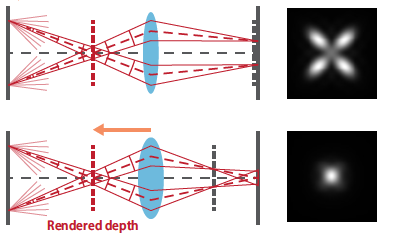
Light field (LF) displays are a promising 3D display technology to mitigate the vergence-accommodation conflict. Recently, we have proposed a simulation framework to model an LF display system. It has predicted that the in-focus optical resolution on the retina would drop as the relative depth of a rendered image to the display-specific optical reference depth grows. In this study, we examine the empirical optical resolution of a near-eye LF display prototype by capturing rendered test images and compare it to simulation results based on the previously developed computational model. We use an LF display prototype that employs a time-multiplexing technique and achieves a high angular resolution of 6-by-6 viewpoints in the eyebox. The test image is rendered at various depths ranging 0–3 diopters, and the optical resolution of the best-focus images is analyzed from images captured by a camera. Additionally, we compare the measurement results to the simulation results, discussing theoretical and practical limitations of LF displays.

Many current far-eye 3D displays are incapable of providing accurate out-of-focus blur on the retina and hence cause discomfort with prolonged use. This out-of-focus blur rendered on the retina is an important stimulus for the accommodation response of the eye and hence is one of the major depth cues. Properly designed integral displays can render this out-of-focus blur accurately. In this paper, we report a rigorous simulation study of far-eye integral displays to study their ability to render depth and the out-of-focus blur on the retina. The beam propagation simulation includes the effects of diffraction from light propagation through the free space, the apertures of lenslet and the eye pupil, to calculate spot sizes on the retina formed by multiple views entering the eye. Upon comparing them with the spot sizes from the real objects and taking into account depth of field and spatial resolution of the eye, we determine the minimum number of views needed in the pupil for accurate retinal blur. In other words, we determine the minimum pixel pitch needed for the screen of a given integral display configuration. We do this for integral displays with varying pixel sizes, lenslet parameters and viewing distances to confirm our results. One of the key results of the study is that roughly 10 views are needed in a 4 mm pupil to generate out-of-focus blur similar to the real world. The 10 views are along one dimension only and out-focus-blur is only analyzed for the fovea. We also note that about 20 views in a 4 mm pupil in one dimension in the pupil would be more than sufficient for accurate out-of-focus blur on the fovea. Although 2-3 views in the pupil may start triggering accommodation response as shown previously, much higher density of views is needed to mimic the real world blur.